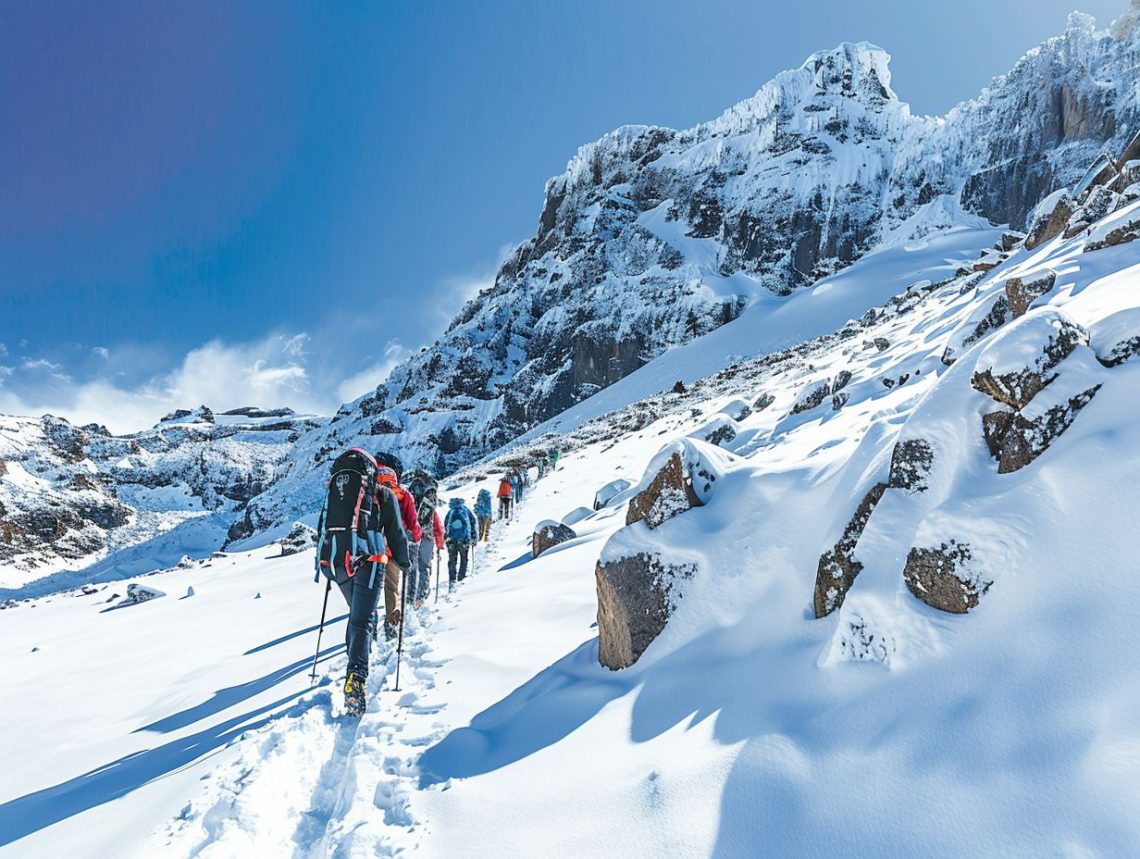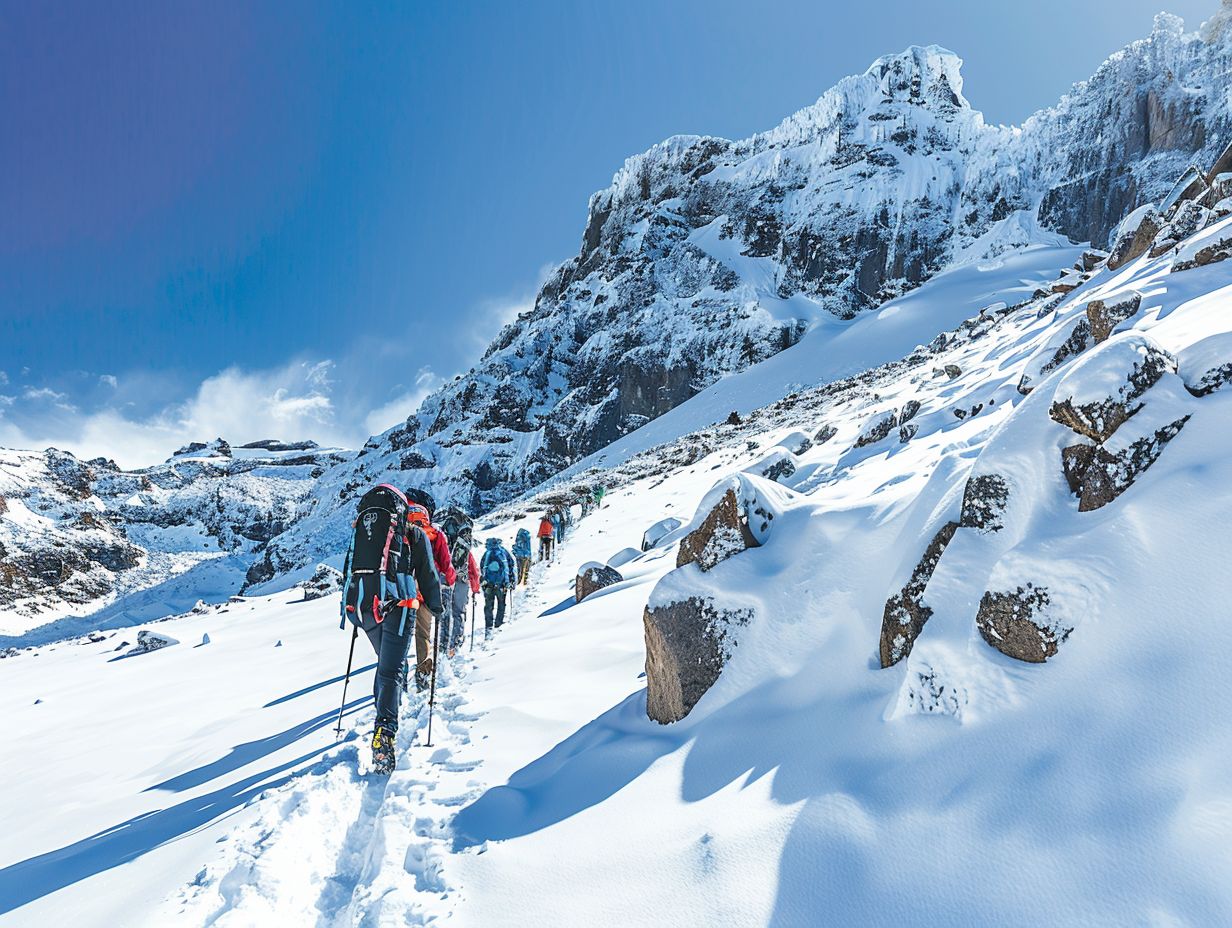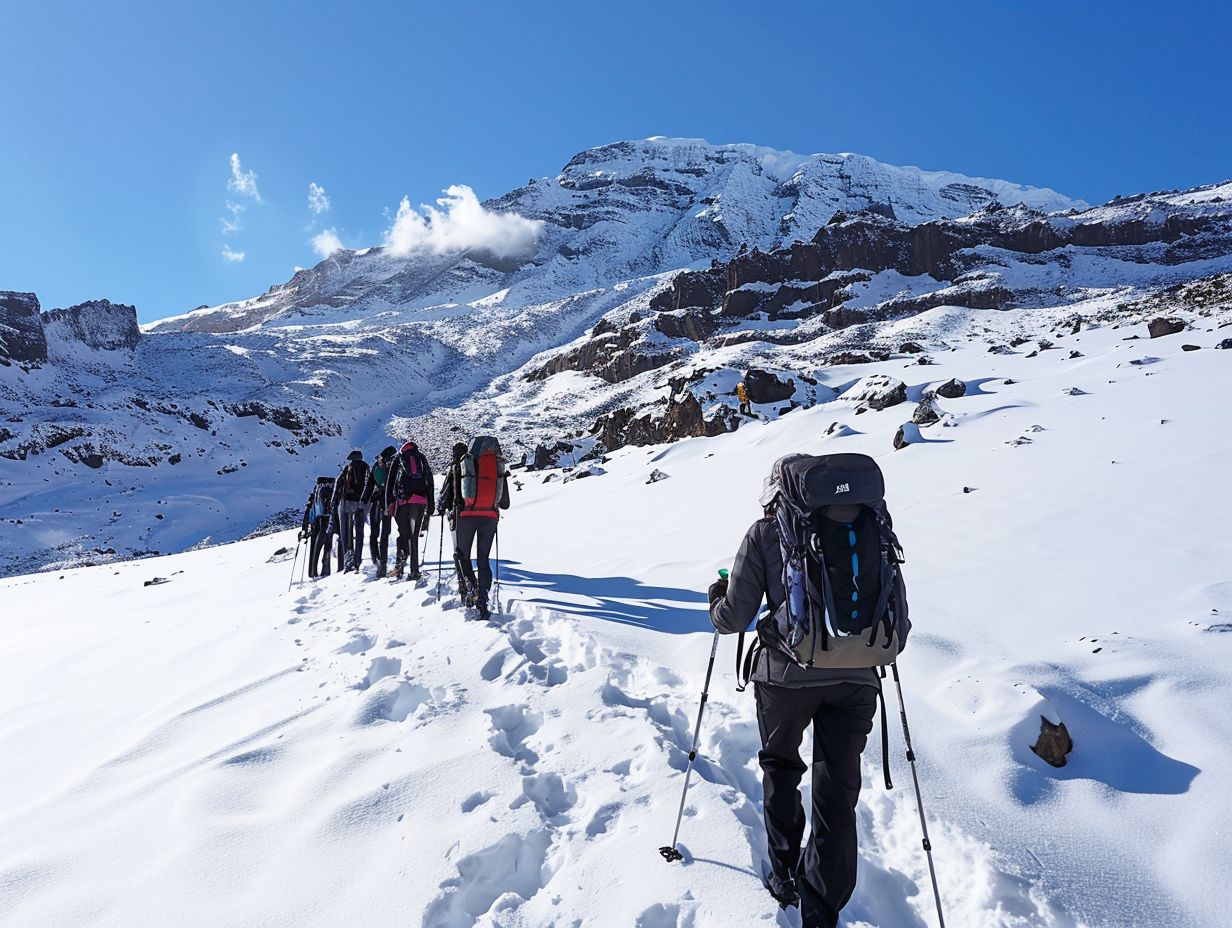
Climbing Kilimanjaro In November
Are you considering climbing Kilimanjaro in November but unsure of what to expect?
This comprehensive guide covers everything you need to know before embarking on this adventure.
From weather conditions and tourist crowds to the different routes available, necessary equipment and gear, physical requirements, and essential tips for a successful climb, we have you covered.
By the end of this article, you’ll have a clear understanding of whether climbing Kilimanjaro in November is the right choice for you.
Key Takeaways:

- November is an ideal time to climb Kilimanjaro due to favorable weather conditions and fewer tourist crowds.
- The Machame, Lemosho, and Marangu routes are popular choices for climbing Kilimanjaro in November.
- Proper physical training, acclimatization, and packing essential gear are crucial for a successful climb in November.
What to Expect when Climbing Kilimanjaro in November?
Climbing Kilimanjaro in November offers a unique experience with varying weather conditions, diverse routes, and the chance to witness stunning views.
1. Weather Conditions in November
November on Kilimanjaro transitions from the tail end of the dry season to the beginning of the short rainy season.
This shift can bring unpredictable weather patterns, including sudden rain showers and mist, affecting visibility and temperature gradients across the various climate zones.
As climbers ascend the mountain, they encounter distinct climate zones, each characterized by its unique weather conditions.
The lower slopes might experience warmer temperatures during the daytime, but as they progress higher, they will encounter cooler air .
A reliable weather forecast becomes a vital tool for mountaineers as they plan their climb.
To be prepared for sudden changes in weather, it is essential to bring adequate layers of clothing, with moisture-wicking properties to stay dry and warm.
2. Tourist Crowds in November
November typically sees moderate tourist crowds, providing a balance between encountering fellow climbers for camaraderie and enjoying relatively quieter trails.
The visibility may vary due to weather conditions, influencing the overall trekking experience and safety aspects.
In November, the trails of Kilimanjaro are usually less crowded compared to peak months, allowing climbers to appreciate the serene beauty of the surroundings.
The fluctuating visibility can impact route navigation, making it crucial for climbers to stay attentive and follow designated paths.
Practicing situational awareness becomes even more critical during these times to ensure safe and enjoyable trekking adventures.
3. Availability of Permits and Guides
Securing permits and experienced guides for a Kilimanjaro climb in November is crucial for both regulatory compliance and ensuring a successful ascent.
The availability of permits might vary based on the season, so early booking is advisable to secure your spot and the services of a knowledgeable guide.
Obtaining the necessary permits for Mount Kilimanjaro is not only a formality; it is a way to manage the number of climbers on the mountain.
Permits serve as a means of regulating tourism, ensuring sustainable trekking practices, and promoting conservation efforts.
Having a qualified guide by your side can make a significant difference in your climbing experience.
These seasoned professionals possess invaluable knowledge of the terrain, weather conditions, and emergency protocols specific to Kilimanjaro.
What are the Different Routes to Climb Kilimanjaro in November?
In November, climbers have a variety of routes to choose from when ascending Kilimanjaro, each offering unique challenges and breathtaking vistas.
1. Machame Route

The Machame Route, also known as the ‘Whiskey Route,’ is a popular choice for climbers tackling Kilimanjaro in November due to its scenic diversity.
This route offers a good balance of challenge and success rates, leading climbers through varying climate zones towards the summit.
Trekkers encounter a range of terrains, from lush rainforests at the lower altitudes to rocky landscapes as they ascend towards the higher campgrounds.
The different campsites on this route, such as Machame Camp, Shira Camp, Barranco Camp, and Barafu Camp, provide trekkers with essential rest stops and acclimatization points during the hike.
November’s weather on the Machame Route typically presents cool temperatures during the day, making it ideal for a comfortable trek.
As the climbers reach the higher altitudes, they may face cold nights and chilly mornings, requiring proper gear for warmth and comfort.
Strategically, trekkers should pace themselves, staying hydrated and well-rested to combat the challenges presented by the altitude and steep sections along the route.
Acclimatization days at key campsites like Barranco Camp also play a crucial role in preparing climbers for the final push to the summit.
2. Lemosho Route
The Lemosho Route stands out as a scenic and less crowded option for November climbers seeking a longer trekking experience with higher success rates.
This route offers gradual acclimatization opportunities and stunning views of the mountain’s various facets, making it a preferred choice for those looking for a balanced journey.
The Lemosho Route provides climbers with a chance to experience diverse landscapes, from lush rainforests to alpine deserts, creating a truly immersive adventure.
The route’s longer duration allows for better altitude adaptation, reducing the risk of altitude sickness and increasing summit success rates.
Guides play a crucial role on this route, ensuring safety, navigation, and offering insights into the local flora and fauna.
Their expertise enhances the overall experience, making the climb not just challenging but also informative and enriching.
3. Marangu Route
The Marangu Route, often referred to as the ‘Coca-Cola Route,’ is known for its huts accommodation and popularity among beginners.
In November, climbers can expect well-trodden trails and a relatively comfortable climb, though careful safety measures and appropriate gear are essential for a successful ascent.
Unlike other routes on Mount Kilimanjaro, the Marangu Route offers the unique feature of sleeping in huts rather than tents.
The infrastructure along the route includes designated sleeping quarters, dining areas, and even toilets, making it a preferred choice.
Climbers should still be prepared for challenging conditions and changing weather patterns, especially during the rainy season in November.
Proper gear, including sturdy hiking boots, warm clothing, and a reliable headlamp, is crucial for navigating the route safely.
4. Rongai Route
The Rongai Route, known for its approach from the north, offers a unique perspective of Kilimanjaro’s wilderness and diverse flora.
November climbers on this route may benefit from good visibility, especially during full moon nights, enhancing the enchanting experience of ascending Africa’s highest peak.
One of the distinguishing features of the Rongai Route in November is its stunning scenic beauty.
The trail on this route meanders through breathtaking landscapes, including lush rainforests, alpine meadows, and rugged terrains, providing climbers with a visual feast.
The varying ecosystems encountered along the way make the journey an unforgettable adventure.
The weather conditions in November are generally favorable, with lower chances of precipitation compared to other months.
The clear skies during this time not only make the climb visually appealing but also ensure that climbers can appreciate the vast expanse of the surrounding landscapes.
5. Umbwe Route
The Umbwe Route, renowned for its steep and direct approach, provides a challenging yet rewarding experience for November climbers seeking a less crowded trail.
This route offers stunning views, especially at sunrise, and demands a good physical condition and navigation skills to conquer its rugged trails.
The steep terrain of this path requires trekkers to navigate rocky sections and steep inclines, making it a physically demanding ascent.
The trail’s challenging nature is balanced by the breathtaking panoramic views it offers, showcasing the beauty of Kilimanjaro’s landscapes.
Visibility conditions also play a significant role in ensuring a successful summit, with weather changes affecting trekking conditions.
Proper trail navigation skills are essential for hikers to stay on track and reach their goals safely and efficiently.
What are the Necessary Equipment and Gear for Climbing Kilimanjaro in November?
Climbing Kilimanjaro in November requires careful selection of equipment and gear to ensure comfort, safety, and success.
From insulated clothing for varying temperatures to sturdy footwear for rugged trails, having the right gear can significantly enhance your climbing experience.
When preparing for a November Kilimanjaro climb, layered clothing is essential to regulate body temperature as you make your way through diverse climate zones.
Start with a moisture-wicking base layer to keep sweat at bay, add insulating mid-layers, and top it off with a waterproof and windproof outer shell.
A durable and supportive pair of hiking boots with good ankle support and a grippy sole is vital for navigating the rocky terrain.
What are the Physical Requirements for Climbing Kilimanjaro in November?

Ascending Kilimanjaro in November demands a certain level of physical fitness and endurance to navigate the challenging terrains and acclimatize to changing altitudes.
Proper training and preparation are essential for climbers to tackle the rigors of the climb and optimize their chances of a successful summit.
At altitudes exceeding 19,000 feet, the lack of oxygen poses a significant challenge for climbers, requiring the body to adapt gradually to prevent altitude-related illnesses.
Altitude adaptation techniques, like the ‘climb high, sleep low’ method, help climbers acclimatize by ascending higher altitudes during the day and descending to sleep.
It’s crucial for climbers to recognize signs of altitude sickness and know when to rest or descend.
Mental fortitude is equally vital, as the mental challenges of the climb can be as demanding as the physical ones.
Tips for a Successful Kilimanjaro Climb in November
Embarking on a Kilimanjaro climb in November requires careful planning and adherence to essential tips to enhance your chances of a successful ascent.
From rigorous training and proper acclimatization to packing wisely and following safety protocols, incorporating these tips can make your November climb rewarding.
1. Train and Prepare Physically
Prioritize physical training and preparation in the months leading up to your November Kilimanjaro climb to build endurance, strength, and stamina required for the ascent.
A well-rounded fitness regimen focusing on cardiovascular exercises, strength training, and hiking practice can significantly improve your readiness.
Cardiovascular fitness is crucial for sustaining endurance during the long hours of climbing. Incorporate activities like running, cycling, or swimming.
Strength training targeting major muscle groups will enhance your physical capabilities for navigating the rugged terrains, especially focusing on core, legs, and upper body.
Hiking practice with elevation gain mimicking the mountainous terrain provides practical experience and helps condition your muscles for the arduous journey.
2. Acclimatize Properly
Effective acclimatization is key to a successful climb, as it helps your body adjust to the changing altitudes and reduces the risk of altitude-related illnesses.
Gradual ascent, hydration, and rest breaks are essential acclimatization strategies to ensure your safety and well-being during the trek.
Gradual ascent allows your body to acclimate slowly, giving it time to adjust to the decreasing oxygen levels as you gain altitude.
This method aids in reducing the chances of altitude sickness, such as headaches, nausea, and fatigue, which can hinder your climb.
Hydration is crucial in combating altitude effects; keeping yourself properly hydrated helps your body function optimally at higher elevations.
Strategic rest intervals during your ascent provide vital recovery time for your muscles and allow your body to recuperate efficiently.
3. Pack Wisely and Lightly
Packing smartly and lightly for your November Kilimanjaro climb is essential to minimize excess weight and optimize your mobility on the trails.
- Prioritize essential gear such as insulated clothing, waterproof layers, sturdy footwear, and safety equipment while avoiding unnecessary items.
- Consider the layering technique to regulate body temperature effectively in changing weather conditions.
- Pack high-energy snacks, a refillable water bottle, a headlamp, a first-aid kit, and sunglasses for sun protection.
Remember to bring a good quality backpack with proper weight distribution and support to prevent strain on your back during the ascent.
4. Stay Hydrated and Well-Nourished
Maintaining proper hydration and nutrition levels throughout your climb is vital for sustaining energy, enhancing performance, and preventing altitude-related issues.
Carry an adequate supply of water, snacks, and balanced meals to fuel your body during the trek while being mindful of staying hydrated and well-fed at high altitudes.
Ensuring adequate hydration is key to combating altitude sickness and fatigue on the demanding slopes of Kilimanjaro.
Go for electrolyte-rich drinks or water purification tablets to replenish essential nutrients lost through sweating at higher altitudes.
Regarding trail snacks, prioritize lightweight options like nuts, dried fruits, and energy bars that offer sustained energy without weighing you down physically.
Planning balanced meals with a mix of carbohydrates, proteins, and fats is crucial for endurance and recovery during the climb.
5. Listen to Your Guide and Follow Safety Protocols

Your guide is your key ally in navigating the challenges, providing expertise, support, and crucial safety guidance throughout the expedition.
It is essential to heed their advice, follow safety protocols diligently, and trust their judgment to ensure a smooth and secure journey to the summit.
November climbs on Kilimanjaro pose unique challenges due to variable weather conditions and unpredictable terrain.
Guides, with their deep knowledge of the mountain and experience navigating its twists and turns, play a pivotal role in ensuring climbers’ safety.
Clear communication with your guide is paramount to address any hurdles that may arise, such as sudden weather changes or altitude-related issues.
Being aware of your surroundings, maintaining proper visibility, and promptly informing your guide of any discomfort or distress signals contribute to a safer ascent.
Conclusion
Deciding to climb Kilimanjaro in November hinges on various factors including your fitness level, trekking experience, weather preferences, and appetite for adventure.
Assessing these aspects carefully of a November ascent can help you determine if this iconic climb aligns with your goals and aspirations.
Physical readiness is paramount for taking on the challenge, with a steady exercise routine helping build stamina and strength required for the demanding climb.
November typically offers clear skies and moderate temperatures but it’s essential to be prepared for sudden weather changes at higher altitudes.
Personal motivations play a significant role, whether it’s conquering a personal goal, seeking a new adventure, or simply being in awe of the breathtaking landscapes.
Reflect on these aspects to ensure your readiness and commitment before embarking on this journey.
Frequently Asked Questions
1. When is the best time to climb Kilimanjaro?
A: The best time to climb Kilimanjaro is during the dry season which is from June to October and from December to February. However, November is also a good time to climb as it is the start of the dry season and offers slightly lower crowds.
2. What is the weather like on Kilimanjaro in November?
A: In November, the weather on Kilimanjaro is generally mild with temperatures ranging from 55-70°F (13-21°C) during the day and dropping to freezing temperatures at night. It is also the start of the short rainy season, so be prepared for some rain.
3. Is November a good time to avoid crowds on Kilimanjaro?
A: Yes, November is a good time to avoid crowds on Kilimanjaro as it is the start of the low season. However, it is still important to book your climb in advance to secure your spot and avoid disappointment.
4. What should I pack for climbing Kilimanjaro in November?
A: You should pack for all weather conditions including warm layers, rain gear, and a good quality sleeping bag. It is also important to bring sturdy hiking boots and a comfortable day pack for the climb. Be sure to check with your tour operator for a full list of recommended items.
5. Are there any special precautions to take when climbing Kilimanjaro in November?
A: It is important to be prepared for the colder temperatures and potential rain during the climb in November. It is also recommended to acclimatize properly and to listen to your guide’s instructions to ensure a safe and successful climb.
6. Do I need to be an experienced climber to climb Kilimanjaro in November?
A: No, you do not need to be an experienced climber to climb Kilimanjaro in November. However, it is important to have a good level of physical fitness and to be mentally prepared for the challenges of high altitude trekking. It is also recommended to train and prepare for the climb beforehand.